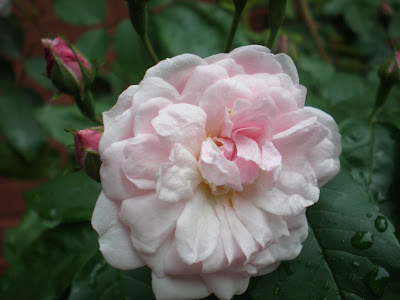Another survivor

Here’s a favorite potted plant that, like Charlotte, was bought from a vendor I haven’t had dealings with in ages. Back in 2000 or so, I ordered a few roses from Hortico, a Canadian mail order rose company. If I remember, I ordered St Joseph’s Coat, Blush Noisette, and Gloire de Dijon. There may have been two others. They were bareroot, and even in those pre-9/11 days, took some time to make their way to me.
Too long. The St. Joseph’s Coat didn’t make it over the border. The Gloire de Dijon failed. I am certain there were a couple other roses from this vendor that quietly faded away before producing blooms. Those were the days when I eagerly ordered everything in sight, especially roses, dreaming of a big rose garden where old garden types and modern types mingled riotously—an explosion of blooms. I read the rose forums at Gardenweb, religiously buying whatever chemicals they said worked.
Well, those days are long over. I no longer use fungicides or pesticides. I’ve accepted that midge will often destroy second bloom periods. I now know how long it takes a bareroot rose to mature and produce a decent amount of blooms. And thank goodness I read up about Blush Noisette before I planted it.

Blush Noisette is not winter-hardy in my zone. So I planted it in a large container, and every November, I drag it into the root cellar, where it contentedly goes dormant. In April I bring it back out. I use a water-soluble fertilizer and it blooms all summer long. A lovely rose that was bred in the Southern U.S. in 1817.
I find the scent to be best early in the bloom cycle—it’s a classic, winy rose scent.
Comments
Cathy
There is no way to kill them, except maybe by using the deadliest of poisons, which I won't do. Anyway, I'm not even sure that works.
Just last week, I dug up two Madame Isaac Periere rose bushes which had too much blackspot. I don't want to spray anymore either.~~Dee